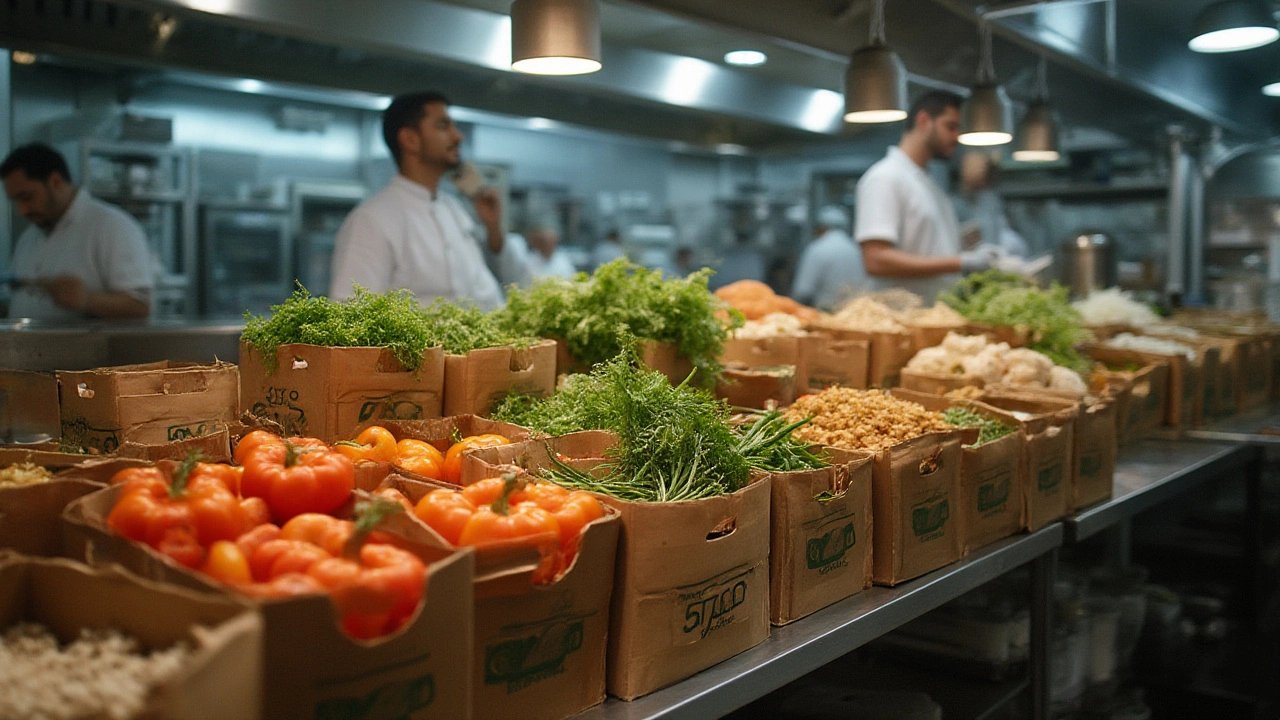Do Restaurants Use Sysco? Inside the Supply Chain of American Eateries

Imagine you’re sitting in your favorite local diner, about to dig into a gigantic club sandwich stacked mile-high. Have you ever wondered how all those crispy fries, golden buns, and heaps of turkey made it onto your plate? Spoiler: there’s a good chance the food in front of you arrived in a giant truck with SYSCO plastered on the side. Whether you’re a curious eater or thinking of jumping into the restaurant business, the truth might surprise you—Sysco is huge, and its trucks are the backbone of countless commercial kitchens.
Who Exactly Is Sysco and How Did They Become So Big?
Sysco isn’t just another food distributor; it’s the world’s largest. The company started out in 1969 in Houston, Texas, when several local suppliers joined forces. But they didn’t stay local for long. Since then, Sysco has grown into a supply giant, with more than 330 distribution facilities across the globe. In fiscal year 2024, Sysco’s revenue hit about $77 billion—mind-blowing, right? With such scale, it’s easy to see why their trucks are parked behind everything from tiny coffee shops to slick, high-end steakhouses.
So, what do they actually do? Sysco connects the dots between food manufacturers—think huge poultry farms, produce growers, and bakeries—and everyone who feeds hungry mouths. That means restaurants, schools, hospitals, hotels, and even cruise ships. If you imagine a commercial kitchen’s shopping list—flour, beef, lettuce, ketchup, cleaning supplies, even to-go boxes—chances are Sysco supplies it. With over 650,000 products, Sysco doesn’t just offer the basics. Their inventory is crazy varied: frozen appetizers, specialty cheeses, bulk oils, spices, craft sodas, eco-friendly napkins, you name it.
Why has Sysco gotten so popular? It’s about convenience, quality, and reliability. Most restaurants, especially chains or new startups, can’t deal with calling dozens of vendors for every item. Sysco acts like a one-stop-shop. They offer next-day delivery in a huge portion of North America and handle logistics on behalf of chefs and managers. One long-time restaurateur, quoted in Restaurant Business Magazine, said
"Sysco gives us access to a huge range of products we’d never get from small local distributors. And if you run out of something, they’ll bend over backward to get it on the next truck."That speed is gold—nobody wants to tell guests the kitchen’s out of salmon again.
But it’s not just medium-sized places using Sysco. Even some of the fanciest spots in New York or San Francisco rely on Sysco for part of their supply—maybe not the artisanal cheese or heirloom tomatoes, but the basic goods every kitchen needs: cooking oil, flour, or plastic wrap. There’s a reliability to Sysco that smaller or specialty vendors can’t promise, and that reliability keeps the back of house running smooth.
Do All Restaurants Use Sysco, or Just Certain Kinds?
The honest truth is—no, not all restaurants use Sysco. But a huge chunk of them do. Fast food, casual dining, hotel restaurants, catering companies, and even schools are regular Sysco customers. A couple of years ago, analysts estimated Sysco held about 17% of the US broadline food service distribution market—way ahead of its biggest competitor, US Foods, which had roughly 10%. So if you’re eating at a national chain, a diner, or even grabbing a sandwich at your hospital’s cafe, odds are good you’ve tasted something from a Sysco shipment.
That doesn’t mean fine dining shuns them. Even if the chef sources local greens and rare mushrooms, Sysco usually fills in those everyday gaps. Butter, eggs, dry goods—they come from somewhere, and Sysco is often the cheapest and easiest source. Restaurant margins are razor thin. Every minute spent negotiating with small suppliers is a minute away from the line, and those Sysco invoices are tidy and predictable.
Here’s the deal, though—many trendy restaurants brag about their farm-to-table cred, posting Instagram shots of delivery from a local organic farm. Behind the scenes, the olive oil might still come from Sysco’s warehouse. It’s practical. Even restaurants fully committed to supporting local agriculture tend to supplement with big distributor orders for paper towels, cleaning products, frozen fries, and essentials with a crazy shelf life.
Sometimes it’s not even about food. Sysco ships kitchen gear, gloves, cleaning supplies, and branded packaging. Try tracking down 10,000 identical takeout boxes on a moment’s notice from local makers! Most local producers just don’t work on that scale.
The flip side? Certain restaurants and food businesses avoid Sysco altogether, often for philosophy or branding. Some mom-and-pop cafes truly buy everything from farmers’ markets and small local suppliers. Niche concepts—like vegan-only spots, gluten-free bakeries, or restaurants that specialize in rare ethnic cuisines—often deal with their own specialty distributors. Still, those places make up a small slice of the scene.

What Does Sysco Actually Deliver? The Real List
If it’s edible or remotely related to eating, Sysco probably has it. Their product catalog clocks in at over 650,000 items. Here’s a look at what fills up a standard Sysco delivery truck:
- Fresh produce: lettuce, potatoes, apples, carrots—Sysco buys in bulk and promises speedy delivery. While it isn’t usually the rare heirloom, it’s consistent and affordable.
- Meats: chicken breasts, ground beef, pork ribs, seafood—portion-cut and pre-packed, ready to go.
- Dairy: cheeses, butter, milk, eggs, sour cream—standard or specialty varieties.
- Dry goods: flour, sugar, pasta, rice, canned beans—bulk orders, cheaper unit prices.
- Prepared foods and frozen items: fries, burger patties, breaded chicken, desserts—kitchen-ready for busy cooks.
- Beverages: sodas, coffee, teas, bottled juices, even beer or wine in some regions.
- Paper products and cleaning supplies: napkins, paper towels, takeout packaging, dish soap, sanitizers, gloves.
- Kitchenware: knives, pans, utensils, plates, serving gear.
Sysco has an in-house brand called Sysco Classic (good for everyday basics) and a premium brand, Sysco Imperial. They also carry big-name products—Heinz, Tyson, Nestlé—which feels familiar for operators who need consistency. Some restaurants opt for Sysco’s “white label” stuff to save even more, which often comes straight from the same factories making popular name brands.
Here’s a snapshot of a typical week’s order for a mid-size American diner (all numbers estimated based on 2024 supplier data):
| Product | Volume | Frequency |
|---|---|---|
| Frozen fries | 120 lbs | Weekly |
| Ground beef | 80 lbs | Twice/week |
| To-go containers | 500 units | Biweekly |
| Fresh lettuce cases | 16 cases | Weekly |
| Sliced cheese | 30 lbs | Weekly |
That’s just a sliver. Multiply by thousands of customers per region, and you see why Sysco’s reach is enormous.
There are also some surprising specialty items in Sysco's warehouse. Need gluten-free breadcrumbs, organic flour, or vegan cheese? Sysco's catalog has it. If a big customer asks for something unusual and there's a market for it, chances are Sysco will start stocking it. This flexibility keeps them ahead of regional competitors who might focus on just the basics.
Sysco’s Real Impact: Why Chefs, Owners, and Diners Care
At this point, you might be asking—does all this matter when you’re eating out? For customers who want to support small farmers or avoid mass-produced ingredients, learning a favorite eatery uses Sysco might feel like a letdown. But dig a little deeper, and things get complicated. For one, restaurants have to balance cost, consistency, quality, and flexibility. It’s stressful dealing with 20 invoices, split deliveries, or supply hiccups. Sysco cuts this hassle out and, amazingly, their logistics system is a miracle of modern supply chain management.
If a chef needs something tomorrow—be it 25 pounds of ground beef or two boxes of disposable gloves—Sysco’s infrastructure makes it happen. According to an interview with The New York Times in March 2024, a Brooklyn-based sous chef said,
"Half of the ingredients we get locally, but we rely on Sysco for anything boring or high-volume. It’s just not practical otherwise."That’s the reality for most spots not charging $200 a plate.
Sysco’s influence does come with trade-offs. There’s criticism, especially from food activists and some chefs, that Sysco’s system encourages uniformity and can edge out smaller suppliers. And let’s be honest: if every eatery buys the same pre-cut veggies and desserts, things can get bland. But it’s a tool, not the whole toolbox. Smart chefs use Sysco to handle those generic, low-margin necessities and spend their time and money focusing on special touches elsewhere.
For restaurant owners starting out, Sysco is almost always a first stop. They offer credit terms, basic business coaching, and product know-how that can be lifesavers for green entrepreneurs. Plus, their buying power means prices tend to beat most local competitors. That kind of scale gives smaller restaurants a fighting chance to survive, especially during tight times like the COVID-19 pandemic, when consistent shipments kept many kitchens afloat even as local supply lines broke down.
If you’re a diner, the presence of Sysco isn’t a scarlet letter. Sometimes it’s the glue that keeps your favorite food spot open. If you want to taste the wildest, freshest, most local food, ask your server where specific ingredients come from. You might be surprised at how many restaurants work their menu around both Sysco’s supply and their local finds.
Now for a quick hack—if you run a small eatery, don’t be shy about negotiating with Sysco reps. Their list prices aren’t set in stone, and the more you buy, the better your deal gets. And if you’re craving restaurant staples at home, there’s good news: since 2020, Sysco has piloted selling directly to consumers in some cities, letting home cooks buy restaurant-grade ingredients straight from the warehouse. Heads up—portions are huge, but it’s a fun way to eat like the pros.
Sysco is everywhere, quietly at the heart of how America eats. Whether you love them, avoid them, or never gave them a thought until now, their influence shapes what’s on your plate most nights out. If you ever spot a giant white truck idling behind your go-to lunch spot, now you know: that’s where dinner begins.